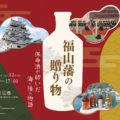KYUSHU & OKINAWA GEOGRAPHICAL INDICATION
九州と沖縄の地理的表示
The following is a part of 48 Japanese GI products that are protected in the EU.(as of September 2020).
日本の GI 産品のうち、EU 内で保護される日本の GI48 品をご紹介します。(2020年9月現在 )
TRADITIONAL AUTHENTIC YAME GYOKURO
八女伝統本玉露

TRADITIONAL AUTHENTIC YAME GYOKURO is Japanese tea with a fragrant aroma. The fresh, hand-picked leaves are produced in Yame City and surrounding mountainous areas and are processed using traditional methods.Among Japanese tea, “Gyokuro” is characterized by its distinctive aonori (green laver)-like aroma called a “blanket scent” by covering the raw leaves while they are growing. In general, “Gyokuro tea” is covered with chemical fibre materials, but for the fresh leaves of Traditional Authentic Yame Gyokuro, natural materials are used, such as rice straw. Compared to chemical fibre materials, the temperature and humidity inside the coating are more suitable for tea bud growth. Whereas the harvesting surface of regular Gyokuro is grown so as to be hemispherical, this Gyokuro tree is left to grow naturally so that sufficient nutrients are allowed to reach each tea bud.

八女市及び周辺市町の中山間地域で生産される生葉を手摘みし、伝統の手法で加工した、香り豊かな「仕上げ茶」です。玉露は、原料の生葉を生育する間被覆することにより、「覆い香」と呼ばれる特有の青海苔様の香りを有するのが特徴です。一般的には化学繊維資材を用いて被覆しますが、「八女伝統本玉露」の原料生葉は、稲わらや「すまき」という稲わら、葦等を粗く編んだ天然資材を用います。化学繊維資材に比べ、被覆内の温湿度環境が茶芽の生育に好適であり、かつ、「自然仕立て」により茶芽の一つ一つに十分な養分が送られるため、鮮緑色かつ艶が生まれます。

KUMAMOTO KENSAN IGUSA
くまもと県産い草

KUMAMOTO KENSAN IGUSA is the soft rush transformed into beautiful high-quality tatami facing by a traditional “mud-dyeing” method. The white cotton-like structure inside the soft rush forms a dense honeycomb, which has excellent humidity adjusting and harmful substance adsorption properties.Kumamoto Prefecture is regarded as a very distinctive region of Japan for soft rush, and soft rush grown in Yatsushiro City, Hikawa Town, Uki City, and Asagiri Town in Kumamoto Prefecture accounts for as much as 90% of the nation’s tatami production.

伝統的に行なわれている「泥染め」により高品質を長きに渡って保つことができるい草です。基準化された栽培方法や品種の管理が遵守されているため、いぐさ内部の白い綿のようなものが網目状に張り巡らされたハニカム構造がしっかりと詰まった密度の高いものが出来上がり、い草が有する調湿性能や有害物質吸着性能が十二分に発揮されます。熊本県の八代市、氷川町、宇城市、あさぎり町で栽培されるいぐさが全国生産量の約9割を占めていることから、いぐさと言えば熊本県産が代表的なものとして認知されています。


OITA KABOSU
大分かぼす

OITA KABOSU is a type of citrus fruit cultivated in Oita Prefecture. It is harvested when green and its fragrance is most pronounced and is then shipped to fruit and vegetable markets. Featuring a refreshing scent and not-too-strong acidity, its juice is used for cooking, where its excellent flavour complements the original taste of the ingredients.In general, kabosu are harvested as green fruits from late August in open-field cultivation. Although they turn yellow from October to November, Oita Kabosu harvested before then are stored, and not shipped until around February the following year. Moreover, from March onwards, kabosu grown in greenhouses are shipped, leading the establishment of an all-year-round system called “Green kabosu”.
大分県内で栽培されたかぼす果実であり、芳香が最高となる緑色の時期に収穫し、青果向けに出荷されています。さわやかな香りと強すぎない酸味が特徴で、果汁を搾って料理に使うことにより、その優れた風味が食材の本来の味を引き立てます。通常、かぼすは露地栽培では8月下旬から緑色の果実として収穫期を迎えます。10月から11月ごろには黄色に変色していきますが、「大分かぼす」はそれ以前に収穫した果実を貯蔵し、翌年2月頃まで出荷します。さらに、3月からは加温ハウス栽培の出荷が始まり、グリーンかぼすとして周年供給体系が確立されています。
MIYAZAKI BEEF
宮崎牛

Miyazaki Prefecture is home to over 400 km of coastline, and thanks to the warm Kuroshio current that runs through the Pacific Ocean and Kyushu mountains that keep out the cold northerly winds, the area enjoys an excellent climate for animal husbandry all year-round and is home to the leading cattle raising ranches in all of Japan. Enjoying the pedigree of cattle raised over generations within the borders of Miyazaki Prefectures, their excellent calves are reared in superb conditions, with ranchers only producing meat of a BMS no. 4 and above. Miyazaki beef is of the very highest quality, recognised as such nationally, having delicate marbling and producing a sweet taste and mellow aroma that fills the entire mouth with its succulence.
宮崎県は、南北400キロにおよぶ海岸線を有し、太平洋を流れる温かい黒潮と冷たい北風を遮る九州山地によりもたらされる、年間を通じた温暖な気候を生かした畜産が盛んであり、全国屈指の肉用牛飼養頭数を誇っています。県内種雄牛の血統を受け継いだ能力の高い子牛が、恵まれた自然環境で肥育され、さらに肉質等級が4等級以上のものに厳選されることで生み出される宮崎牛は、極上な肉質ときめ細やかなサシを持ち、口に含むと広がるほのかな甘みと芳醇な香りが特徴で、全国規模の共進会等でも高く評価されています。
KAGOSHIMA NO TSUBOZUKURI KUROZU
鹿児島の壺造り黒酢

From the Edo period (1600 – 1868), vinegar made from rice as a raw material in Fukuyama Town, Kagoshima Prefecture, has been brewed using an outdoor pot. As this vinegar goes through the aging process it takes on the color of amber and so it is called Kagoshima no Tsubozukuri Kurozu (Kagoshima’s black pot vinegar, otherwise, black vinegar).Its production method is unique in that fermentation is carried out by using outdoor jars, and after aging, its color changes from brown to black-brown. A characteristic aroma and mellow sourness are said to emanate from the course of this long-term aging.
江戸時代から鹿児島県霧島市福山町において、米を原料にした食酢が屋外で壺を使用して醸造されています。この食酢は熟成期間を経るにつれ、琥珀色に色が付いてくるので、「鹿児島の壺造り黒酢」(以下黒酢)と呼ばれています。屋外に並べた壺を使って仕込み醗酵するという独特な製法で、醗酵に6カ月以上、さらに、6カ月以上の熟成を経て、黒酢の色は褐色から黒褐色を帯びています。そして特有の香りとまろやかな酸味は、この長期熟成の過程で生まれるとされています。
SAKURAJIMA KOMIKAN
桜島小みかん

Whilst smaller in size than their Wenzhou cousins, Sakurajima komikan have an average weight of 50 g and a diameter of less than 5 cm, making them the world’s smallest mandarin oranges. Their skin gives off a fresh, citrusy scent and is often used as a condiment, though their flesh is soft and juicy, and attains the perfect balance between sweet and sour. Cultivated since antiquity, it was long before the late 19th century when Wenzhou mandarin oranges became the norm in Japan. They are grown in the Sakurajima area located almost right in the centre of Kagoshima Prefecture. Today, however, those grown to be eaten raw can only be found in Kagoshima. With a harvest season lasting from around the end of November until the end of December, they have become practically synonymous with wintertime in the region and are a staple year-end gift.
果実は温州ミカンに比べて小粒で、平均的な果実重は50g程度、横径は5cm足らずで世界一小さいミカンと言われています。果皮は柑橘系特有の爽やかな香気を有し、薬味としても利用されており、果肉は柔らかく多汁で、甘さと酸味のバランスがとれた食味の良いミカン。温州ミカンが普及する明治中期以前に栽培されていた系統で、鹿児島県のほぼ中央に位置する桜島で古くから栽培されてきましたが、現在、生食中心の生産は鹿児島のみで行なわれています。収穫期は概ね11月下旬から12月下旬で、鹿児島の冬の風物詩として古くからお歳暮の定番商品になっています。
HETSUKA DAIDAI
辺塚だいだい

This flavourful, sour, and characteristically native citrus has grown in the towns of Kimotsuki and Minamiosumi on the southern tip of the Osumi peninsula in Kagoshima Prefecture since antiquity and has been used by locals to garnish seafood dishes and for making vinegar sauces, a simple staple indispensable to everyday local cuisine. A different species from the bitter orange, its flesh is also of a much smaller size in granularity while its skin is thinner and smoother. When freshly picked during the harvest season running from August until October, their skin is still green and is used as a substitute for vinegar in local cuisine due to their acidity and the large amount of juice they produce. Their skin has the same kind of distinctive aroma as that of limes, but by November and December, when they change to yellow and lose their acidity, they acquire a much more gentle flavour.

鹿児島県の大隅半島南部に位置する肝付町、南大隅町に古くから自生している地域固有の香酸柑橘で、地元では魚のツマやカンキツ酢等に利用され、日常的な食生活に欠かせない果実として親しまれてきました。
ダイダイとは異なる品種で、果実もダイダイに比べて小ぶりで皮が薄く滑らか。収穫が始まる8~10月頃は果皮・果肉とも鮮やかなグリーンで、酸味、果汁が多いことから地元では酢の代用品として使用され、果皮には、ライムにも似た独特な香りがあります。11~12月に果皮がグリーンから黄色になる頃には酸味も抜け、やわらかな酸味とさわやかな風味となります。

KAGOSHIMA KUROUSHI / WAGYU
鹿児島黒牛

If Kuroge Wagyu cattle are primarily raised until slaughter in Kagoshima the beef can be certified as Kagoshima Kuroushi. With a smooth, soft quality to the speckled beef, it is full of unsaturated fatty acids that have a low melting point, creating a delicate yet firm texture that practically melts in the mouth, perfectly balancing fattiness with a savoury taste and making Kagoshima black wagyu famous throughout Japan.
In 2017, at a prize show held once every five years judging the best Wagyu in the country, Kuroge Wagyu took home the top prizes in 4 of the nine total categories, dominating the competition. In the beef cattle category, the breed was awarded an excellence in meat prize which, in addition to the brand receiving the highest marks overall of all competitors, cemented its position as the ultimate brand of beef in all Japan.

鹿児島県における飼養期間が最長かつ最終飼養地である黒毛和種の牛肉です。その肉質は、きめ細かく柔らかい肉質にバランス良く織り込まれた、不飽和脂肪酸と呼ばれる融点の低い霜降りが織りなすとろけるような食感と、繊細ながらもしっかりとした肉と脂の旨みが特徴で、全国的な認知度を有しています。 2017年には、5年に一度の和牛日本一が決定する全国和牛能力共進会で、全9部門のうち4部門を制覇。肉牛部門で「最優秀技肉賞」を獲得するなど総合優勝を果たしており、全国ブランド牛の頂点に輝きました。

RYUKYU MOROMISU
琉球もろみ酢

This non-carbonated beverage comes from the liquid primarily made from Ryukyu mash vinegar by compressing and filtering the dregs of mash used to make the famous Okinawa liquor known as Awamori. By taking the Ryukyu mash vinegar as it is, or after adding a little brown sugar or fruit juice for seasoning, the beverage can be adjusted for either straight consumption or for use in cooking.While amber in colour and sour tasting, it is different from typical table vinegars and black vinegars where the primary acidic component is acetic acid. Ryukyu Moromi Vinegar’s primary acidic component comes from citric acid without assaulting the nostrils nor having any of the astringent aroma associated with vinegar.
琉球泡盛のもろみを蒸留した後に得られる琉球泡盛もろみ粕を圧搾・ろ過することによって得られる液体(琉球もろみ酢原液)を原液とする非発泡性飲料です。琉球泡盛もろみ粕を圧搾・ろ過することによって得られる琉球もろみ酢原液をそのままに、もしくはこれに黒糖や果汁などで香りや味、成分を調整して、飲用のほか、調味料などの料理の材料としても利用されています。琥珀色で酸味がありますが、主な酸味成分が酢酸である食酢や黒酢と違い、琉球もろみ酢の主な酸味成分はクエン酸であるため、鼻にツンとくる刺激や酢酸臭がなく飲みやすいと言えます。





